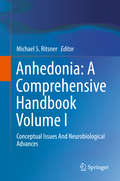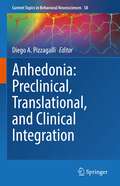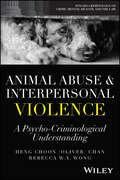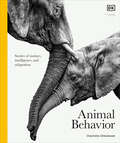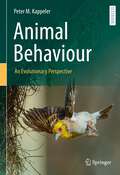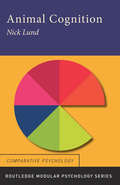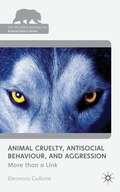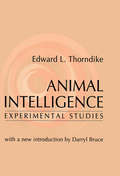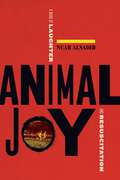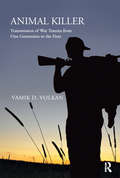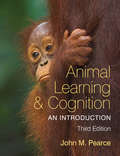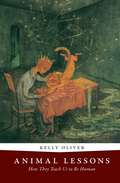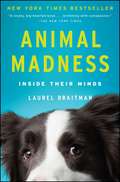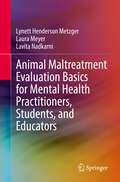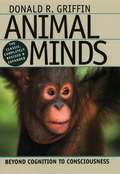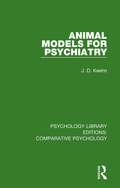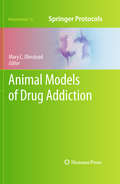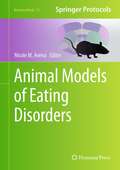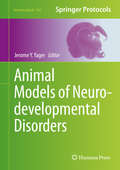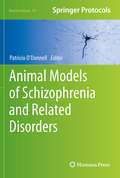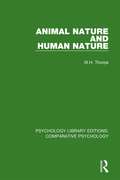- Table View
- List View
Anhedonia: Conceptual Issues And Neurobiological Advances
by Michael S. RitsnerThis is the first comprehensive two-volume collection on anhedonia, a disorder that played an important role in psychopathology theories at the beginning of the twentieth century. Anhedonia is a condition in which the capacity of pleasure is partially or completely lost, and it refers to both a personality trait, and a "state symptom" in various neuropsychiatric and physical disorders. It has a putative neural substrate, originating in the dopaminergic mesolimbic and mesocortical reward circuit. Over the past three decades cognitive psychology and behavioral neuroscience have expanded our understanding of anhedonia and other reward-related processes. The aim of this new two-volume collection on anhedonia is to highlight the contributions of eminent scientists in this field as well as to provide readers with comprehensive accounts of recent developments as perceived by the authors. This monograph is divided into five parts. Volume I contains parts one and two (Conceptual Issues and Neurobiological Advances) including 14 chapters that serve as an introduction and overview of conceptual issues. Volume II contains three parts (Anhedonia in Psychotic Disorders, Anhedonia in Mood and Personality Disorders, and Anhedonia in Neurological and Physical Disorders) including 15 chapters that provide an overview of the construct, measurement of anhedonia in schizophrenia spectrum disorders, hedonic capacity and related factors in schizophrenia and schizoaffective disorder, anhedonia as an indicator of genetic liability for schizophrenia, and as a trait marker for depression, the role of an anhedonia in trauma-related disorders, anorexia nervosa, stress-induced eating disorders, schizotypal traits and risk of suicide. This book will be of interest to a broad spectrum of readers including psychiatrists, psychologists, neurologists, neuroscientists, endocrinologists, pharmacologists, general practitioners, geriatricians, graduate students, and health care providers in the fields of mental health.
Anhedonia: Preclinical, Translational, and Clinical Integration (Current Topics in Behavioral Neurosciences #58)
by Diego A. PizzagalliAnhedonia is a key symptom (and often risk factor) for various neuropsychiatric disorders, including depression, schizophrenia, substance use disorders, post-traumatic stress disorders, and Parkinson's Disease, among others. Across disorders, anhedonia has been associated with worse disease course, including poor response to pharmacological, psychological and neurostimulation treatments as well as completed suicide. Mounting evidence emerging from preclinical and translational sciences has clarified that "anhedonia" can be parsed into partially independent subcomponents, including incentive motivation, consummatory pleasure, reward learning, and effort-based decision making, pointing to distinct neurobiological substrates that could underlie anhedonic phenotypes. Taking an integrative approach that emphasizes cross-species integration and dimensional conceptualization of mental illnesses (e.g., Research Domain Criteria (RDoC)), this book represents the most comprehensive evaluation, synthesis and integration of theories and empirical findings focused on anhedonia.Organized across five parts, the handbook starts with chapters on the history, etiology, and assessments of anhedonia (Part I), followed by a section on the role of anhedonia in psychiatric and neurological disorders (Part II). Using the RDoC Matrix as a guide, Part III presents chapters synthetizing preclinical and clinical findings on different reward processing subdomains (e.g., reward responsiveness, reward valuation, reward learning). Part IV is focused on selected special topics, including historical and current perspectives on the transdiagnostic nature and importance of social anhedonia, the role of inflammation in the pathophysiology of anhedonia, the use of computational modeling to “dissect” anhedonia and improve its understanding, and links between anhedonia and suicide. Finally, Part V includes chapters on pharmacological, psychological and neurostimulation treatments for anhedonia.
Anima and Africa: Jungian Essays on Psyche, Land, and Literature
by Matthew A. FikeC. G. Jung understood the anima in a wide variety of ways but especially as a multifaceted archetype and as a field of energy. In Anima and Africa: Jungian Essays on Psyche, Land, and Literature, Matthew A. Fike uses these principles to analyze male characters in well-known British, American, and African fiction. Jung wrote frequently about the Kore (maiden, matron, crone) and the "stages of eroticism" (Eve, Mary, Helen, Sophia). The feminine principle’s many aspects resonate throughout the study and are emphasized in the opening chapters on Ernest Hemingway, Henry Rider Haggard, and Olive Schreiner. The anima-as-field can be "tapped" just as the collective unconscious can be reached through nekyia or descent. These processes are discussed in the middle chapters on novels by Laurens van der Post, Doris Lessing, and J. M. Coetzee. The final chapters emphasize the anima’s role in political/colonial dysfunction in novels by Barbara Kingsolver, Chinua Achebe/Nadine Gordimer, and Aphra Behn. Anima and Africa applies Jung’s African journeys to literary texts, explores his interest in Haggard, and provides fresh insights into van der Post’s late novels. The study discovers Lessing’s use of Jung’s autobiography, deepens the scholarship on Coetzee’s use of Faust, and explores the anima’s relationship to the personal and collective shadow. It will be essential reading for academics and scholars of Jungian and post-Jungian studies, literary studies, and postcolonial studies, and will also appeal to analytical psychologists and Jungian psychotherapists in practice and in training.
Animal Abuse and Interpersonal Violence: A Psycho-Criminological Understanding (Psycho-Criminology of Crime, Mental Health, and the Law)
by Heng Choon Oliver Chan Rebecca W. Y. WongANIMAL ABUSE & INTERPERSONAL VIOLENCE A COMPREHENSIVE EXAMINATION OF THE CAUSES OF, AND LINKS BETWEEN, INTERPERSONAL AND INTERSPECIES VIOLENCE Animal Abuse & Interpersonal Violence: A Psycho-Criminological Understanding addresses the many aspects of the link between animal cruelty and human violence. Presenting new theory, research, policy, and practice, this authoritative volume explores the subject through a psycho-criminological lens to describe, explain, and potentially prevent intentional behavior that causes pain, suffering, or death in animals and humans. With an integrated theoretical-practical approach, Animal Abuse & Interpersonal Violence offers up-to-date research and provides real-world insights into current thinking in the study of animal abuse and interpersonal violence. Sixteen in-depth chapters by a multidisciplinary team of active researchers and experienced field practitioners examine central topics in the field, including different forms of animal exploitation, connections between animal cruelty and substance abuse, the association between childhood animal cruelty and adult interpersonal violence, the role of veterinarians in the identification of animal abuse cases, the complex legal aspects of animal abuse cases, and more. Advances scholarship on animal abuse, its relationship with interpersonal violence, and the psycho-criminological mechanisms involved in that relationship Introduces readers to contemporary research on a range of topics and issues related to animal abuse and interpersonal violence Examines the origins of animal cruelty, its societal implications, and various prevention and treatment approaches Defines and describes various types of animal maltreatment and their links to different forms of interpersonal violence Animal Abuse & Interpersonal Violence: A Psycho-Criminological Understanding is essential reading for practitioners, researchers, scholars, and advanced students in fields such as behavioral science, law, criminology, veterinary forensics, criminal justice, law enforcement, social work, sociology, social sciences, education, and animal welfare.
Animal Behavior: Life in the Wild (DK Definitive Visual Encyclopedias)
by DKA thrilling face-to-face encounter with animals in their own environment—their elaborate displays, intimate lives, and extraordinary behavior. Did you know that elephants give each other names, orangutans self-medicate, and rats giggle? Animal Behavior is full of hundreds of stories that shed light on how animals navigate life in the wild. Packed with vivid wildlife photography and action sequences, every aspect of animal life and behavior is explored and explained – from courtship rituals and birth to hunting and death. An initial overview of animal anatomy and physiology reveals the science and biomechanics that underpin animal behavior, while later chapters thematically break down the intricacies of animal feeding, development, communication, intelligence, learning, and other behavioral characteristics. Learn about play through river otters, see socialization among parrots at the riverbank, and catch prey with a fishing spider. Feature panels throughout the book explore the biology behind these traits, introduce case studies from the field, and highlight critical conservation issues facing these animals. Animal Behavior has been created in collaboration with internationally renowned zoologist and TV presenter Charlotte Uhlenbroek and a team of wildlife experts to ensure up-to-date and accurate information.
Animal Behaviour: An Evolutionary Perspective
by Peter M. KappelerThis textbook presents all basic principles of animal behaviour in a clear and concise manner and illustrates them with up-to-date examples. Emphasis is placed on behavioural biology as an integrative discipline of organismic biology, focusing on the adaptive value of behaviours that facilitate resource access, predator avoidance and reproductive success and underlie parental care, all within a comprehensive presentation of social complexity. This new textbook provides a rich resource for students (and teachers) from a wide range of life science disciplines.
Animal Cognition (Comparative Cognition and Neuroscience Series)
by H. L. Roitblat H. S. Terrace T. G. BeverFirst published in 1984. With this volume we initiate a series of books in comparative cognition and neuroscience. The presentations at the Harry Frank Guggenheim Conference, June 2-4, 1982, out of which the present volume grew, showed that this field of enquiry into cognitive functioning and its neural basis had reached maturity.
Animal Cognition (Routledge Modular Psychology)
by Nick LundAnimal Cognition looks at how non-human animals process information from their environment. Nick Lund has written an accessible and engaging account of this area of comparative psychology. The book contains chapters on animal navigation (including homing behaviour and migration), animal communication methods and research into animal language, and attempts to teach language to non-human animals. A chapter on memory includes models of memory in non-human animals and discusses the importance of memory in navigation and foraging behaviour.Animal Cognition is designed to cover the AQA(A) A2 level specification but will also be of interest to undergraduates new to comparative psychology. It is well illustrated and includes a study aids section with examination questions and answers, and key research summaries.
Animal Cognition: A Tribute To Donald A. Riley (Comparative Cognition and Neuroscience Series)
by Thomas R. ZentallPrepared as a tribute to Donald A. Riley, the essays that appear here are representative of a research area that has loosely been classified as animal cognition -- a categorization that reflects a functionalist philosophy that was prevalent in Riley's laboratory and that many of his students absorbed. According to this philosophy, it is acceptable to hypothesize that an animal might engage in complex processing of information, as long as one can operationalize evidence for such a process and the hypothesis can be presented in the context of testable predictions that can differentiate it from other mechanisms. The contributions to this volume represent the three most important areas of research in animal cognition -- stimulus representation, memory processes, and perceptual processes -- although current research has considerably blurred these distinctions.
Animal Cruelty, Antisocial Behaviour and Aggression
by Eleonora GulloneDemonstrating that animal cruelty behaviours are another form of antisocial behaviour, alongside human aggression and violence, and almost without exception are carried out by the same individuals this book offers clear recommendations for future research on animal cruelty and future action aimed at prevention.
Animal Intelligence: Experimental Studies
by Edward ThorndikeAnimal Intelligence is a consolidated record of Edward L. Thorndike's theoretical and empirical contributions to the comparative psychology of learning. Thorndike's approach is systematic and comprehensive experimentation using a variety of animals and tasks, all within a laboratory setting. When this book first appeared, it set a compelling example, and helped make the study of animal behavior very much an experimental laboratory science.This landmark study in the investigation of animal intelligence illustrates Thorndike's thinking on the evolution of the mind. It includes his formal statement of the influential law of effect, which had a significant impact on other behaviorists. Hull's law of primary reinforcement was closely related to the law of effect and Skinner acknowledged that the process of operant conditioning was probably that described in the law of effect.The new introduction by Darryl Bruce is an in-depth study of Thorndike's legacy to comparative psychology as well as a thorough retrospective review of Animal Intelligence. He includes a biographical introduction of the behaviorist and then delves into his theories and work. Among the topics Bruce covers with respect to Thorndike's studies are the nature of animal intelligence, the laws of learning and connectionism, implications for comparative psychology, and relation to theories of other behaviorists. Animal Intelligence is an intriguing analysis that will be of importance to psychologists and animal behaviorists.
Animal Joy: A Book of Laughter and Resuscitation
by Nuar AlsadirA Time Must-Read Book of 2022 A Publishers Weekly Best Book of 2022Aster(ix) Journal's 12 Best Nonfiction Books of 2022An invigorating, continuously surprising book about the serious nature of laughter.Laughter shakes us out of our deadness. An outburst of spontaneous laughter is an eruption from the unconscious that, like political resistance, poetry, or self-revelation, expresses a provocative, impish drive to burst free from external constraints. Taking laughter’s revelatory capacity as a starting point, and rooted in Nuar Alsadir’s experience as a poet and psychoanalyst, Animal Joy seeks to recover the sensation of being present and embodied. Writing in a poetic, associative style, blending the personal with the theoretical, Alsadir ranges from her experience in clown school, Anna Karenina’s morphine addiction, Freud’s un-Freudian behaviors, marriage brokers and war brokers, to “Not Jokes,” Abu Ghraib, Frantz’s negrophobia, smut, the Brett Kavanaugh hearings, laugh tracks, the problem with adjectives, and how poetry can wake us up. At the center of the book, however, is the author’s relationship with her daughters, who erupt into the text like sudden, unexpected laughter. These interventions—frank, tender, and always a challenge to the writer and her thinking—are like tiny revolutions, pointedly showing the dangers of being severed from one’s true self and hinting at ways one might be called back to it.A bold and insatiably curious prose debut, Animal Joy is an ode to spontaneity and feeling alive.
Animal Killer: Transmission of War Trauma From One Generation to the Next
by Vamik D. VolkanA psychoanalytic process from its beginning to its termination is described to illustrate crucial technical issues in the treatment of individuals with narcissistic personality organization and the countertransference manifestations such patients stimulate in the analyst. The subject of this book exhibited cruelty to confirm and stabilize his grandiosity. His internal world was a "reservoir" of the deposited image of his father figure, an individual most severely traumatized during World War II. The patient was given the task to be a mass-"killer" of animals instead of being a hunted one.This book most clearly illustrates how the transgenerational transmission of trauma takes place and how the impact of war continues in future generations. The book also provides an understanding of a special kind of psychological motivation that directs a person to use weapons for mass killing. In this era of pluralism in psychoanalysis, providing the story of a psychoanalytic case in its duration opens ways for comparison and discussion of technique and can be used as a teaching tool.
Animal Learning and Cognition: An Introduction
by John M. PearceAnimal Learning and Cognition: An Introduction provides an up-to-date review of the principal findings from more than a century of research into animal intelligence. This new edition has been expanded to take account of the many exciting developments that have occurred over the last ten years. The book opens with a historical survey of the methods that have been used to study animal intelligence, and follows by summarizing the contribution made by learning processes to intelligent behavior. Topics include Pavlovian and instrumental conditioning, discrimination learning, and categorization. The remainder of the book focuses on animal cognition and covers such topics as memory, navigation, social learning, language and communication, and knowledge representation. Expanded areas include extinction (to which an entire chapter is now devoted), navigation in insects, episodic memory in birds, imitation in birds and primates, and the debate about whether primates are aware of mental states in themselves and others. Issues raised throughout the book are reviewed in a concluding chapter that examines how intelligence is distributed throughout the animal kingdom. The broad spectrum of topics covered in this book ensures that it will be of interest to students of psychology, biology, zoology, and neuroscience. Since very little background knowledge is required, the book will be of equal value to anyone simply interested in either animal intelligence, or the animal origins of human intelligence. This textbook is accompanied by online instructor resources which are free of charge to departments who adopt this book as their text. They include chapter-by-chapter lecture slides, an interactive chapter-by-chapter multiple-choice question test bank, and multiple-choice questions in paper and pen format.
Animal Lessons: How They Teach Us to Be Human
by Kelly OliverPhilosophy reads humanity against animality, arguing that "man" is man because he is separate from beast. Deftly challenging this position, Kelly Oliver proves that, in fact, it is the animal that teaches us to be human. Through their sex, their habits, and our perception of their purpose, animals show us how not to be them. This kinship plays out in a number of ways. We sacrifice animals to establish human kinship, but without the animal, the bonds of "brotherhood" fall apart. <P><P>Either kinship with animals is possible or kinship with humans is impossible. Philosophy holds that humans and animals are distinct, but in defending this position, the discipline depends on a discourse that relies on the animal for its very definition of the human. Through these and other examples, Oliver does more than just establish an animal ethics. She transforms ethics by showing how its very origin is dependent upon the animal. Examining for the first time the treatment of the animal in the work of Heidegger, Merleau-Ponty, Derrida, Agamben, Freud, Lacan, and Kristeva, among others, Animal Lessons argues that the animal bites back, thereby reopening the question of the animal for philosophy.
Animal Madness: How Anxious Dogs, Compulsive Parrots, and Elephants in Recovery Help Us Understand Ourselves
by Laurel Braitman**“Science Friday” Summer Reading Pick** **Discover magazine Top 5 Summer Reads** **People magazine Best Summer Reads** “A lovely, big-hearted book…brimming with compassion and the tales of the many, many humans who devote their days to making animals well” (The New York Times).Have you ever wondered if your dog might be a bit depressed? How about heartbroken or homesick? Animal Madness takes these questions seriously, exploring the topic of mental health and recovery in the animal kingdom and turning up lessons that Publishers Weekly calls “Illuminating…Braitman’s delightful balance of humor and poignancy brings each case of life….[Animal Madness’s] continuous dose of hope should prove medicinal for humans and animals alike.” Susan Orlean calls Animal Madness “a marvelous, smart, eloquent book—as much about human emotion as it is about animals and their inner lives.” It is “a gem…that can teach us much about the wildness of our own minds” (Psychology Today).
Animal Maltreatment Evaluation Basics for Mental Health Practitioners, Students, and Educators
by Lynett Henderson Metzger Laura Meyer Lavita NadkarniThis book provides a brief introduction to the growing field of animal maltreatment evaluation and treatment, with a special emphasis on clinical training from a forensic psychology perspective. Geared toward mental health practitioners, students, and educators, this broad overview focuses on foundational legal concepts, applications in clinical and psycholegal settings, and emerging perspectives on effective evaluation and treatment. The authors provide practical guidance around “real world” scenarios through the use of clinical case vignettes, highlighting the complexities and need for culturally- and psychologically-informed care in these cases. Key topics include forensic animal maltreatment evaluations (or FAMEs); implications for best practices; challenges for providers, trainees, and supervisors; and future directions for the field.
Animal Minds: Beyond Cognition to Consciousness
by Donald R. GriffinIn Animal Minds, Donald R. Griffin takes us on a guided tour of the recent explosion of scientific research on animal mentality. Are animals consciously aware of anything, or are they merely living machines, incapable of conscious thoughts or emotional feelings? How can we tell? Such questions have long fascinated Griffin, who has been a pioneer at the forefront of research in animal cognition for decades, and is recognized as one of the leading behavioral ecologists of the twentieth century. With this new edition of his classic book, which he has completely revised and updated, Griffin moves beyond considerations of animal cognition to argue that scientists can and should investigate questions of animal consciousness. Using examples from studies of species ranging from chimpanzees and dolphins to birds and honeybees, he demonstrates how communication among animals can serve as a "window" into what animals think and feel, just as human speech and nonverbal communication tell us most of what we know about the thoughts and feelings of other people. Even when they don't communicate about it, animals respond with sometimes surprising versatility to new situations for which neither their genes nor their previous experiences have prepared them, and Griffin discusses what these behaviors can tell us about animal minds. He also reviews the latest research in cognitive neuroscience, which has revealed startling similarities in the neural mechanisms underlying brain functioning in both humans and other animals. Finally, in four chapters greatly expanded for this edition, Griffin considers the latest scientific research on animal consciousness, pro and con, and explores its profound philosophical and ethical implications.
Animal Models for Psychiatry (Psychology Library Editions: Comparative Psychology)
by J. D. KeehnOriginally published in 1986, in this work Professor Keehn assesses the contributions of experimental psychology and ethology to psychiatric theory and practice at the time. He discusses the status of animals in psychopathology, and describes a number of animal clinical pictures, covering both abnormal movements and convulsions, and spontaneous behavioural disorders. He also includes animal models of such psychiatric illnesses as neurosis, psychosis, drug addiction and disorders of childhood, and examines the nature of mental illness and the status of psychiatric diagnosis. The book includes an evaluation of the ethics of experimental research with animals and a summary of humane experimental procedures. Animal Models for Psychiatry will be of special interest to psychiatrists, clinical and physiological psychologists, behavioural pharmacologists, and to veterinarians.
Animal Models of Drug Addiction (Neuromethods #24)
by Alan A. Boulton Glen B. Baker Peter H. WuA comprehensive guide to the use of animal models for understanding the many facets of drug and alcohol abuse-problems that are now worldwide health concerns. Expert investigators have contributed state-of-the-art chapters on the use of animal models for research on substance abuse.
Animal Models of Drug Addiction (Neuromethods #53)
by Mary C. OlmsteadOur understanding of addiction and how it is treated has advanced remarkably over the past decades, and much of the progress is related directly to animal research. This is true for both the behavioural aspects of drug use as well as the biological underpinnings of the disorder. In Animal Models of Drug Addiction, experts in the field provide an up-to-date review of complex behavioural paradigms that model different stages of this disorder and explain how each test is used to effectively replicate the progression of drug addiction. This detailed and practical book begins with the most common laboratory measures of addiction in animals, including intracranial self-stimulation (ICSS), drug self-administration, place conditioning, and sensitization. Later chapters describe how these paradigms are used to model the progression of drug addiction, providing insight into the clinical symptomatology of addiction from acquisition of drug use through compulsive drug taking to withdrawal and relapse. Written for the popular Neuromethods series, the contributions offer both methodological detail and a theoretical perspective, appealing to readers familiar with preclinical research on drug addiction as well as those who are newcomers to the field. Cutting-edge and authoritative, Animal Models of Drug Addiction will serve as a basis for future vital research that links the bench to the bedside in the crucial treatment of drug addiction.
Animal Models of Eating Disorders (Neuromethods #74)
by Nicole M. AvenaThe growth of the field of eating disorder research has led to a vast array of empirical articles, and the development of new animal models that can be used to study these disorders continues to stimulate new research. Animal Models of Eating Disorders serves as a collection of detailed techniques contributed by experts in the field who are well-versed in the development and implementation of these models. Since eating disorders are complex and likely due to a combination of environmental, genetic, and social causes, the detailed chapters of this volume have been designed to highlight different contributing factors. Collectively, these chapters give a comprehensive and representative overview of both recently developed and classic methodologies used in the study of eating disorders. Written for the popular Neuromethods series, this work contains the kind of thorough description and implementation advice that promises successful results. Authoritative and practical, Animal Models of Eating Disorders aims to aid researchers in the use of animal models to assist in their investigation and characterization of the behaviors and neurochemical alterations associated with these devastating disorders.
Animal Models of Neurodevelopmental Disorders (Neuromethods #104)
by Jerome Y. YagerProviding a spectrum of models that is reflective of the various species that can be utilized in experimentation on disorders across a broad range of developmental disabilities, this volume collects expert contributions involved in investigation of the causes, outcomes, treatment, and prevention. Animal Models of Neurodevelopmental Disorders explores models of perinatal hypoxia-ischemia/cerebral palsy and stroke, autism spectrum disorder, fetal alcohol syndrome, as well as mental retardation. Written in the popular Neuromethods series style, chapters include the kind of detail and key advice from the specialists needed to get successful results in your own laboratory. Practical and authoritative, Animal Models of Neurodevelopmental Disorders serves to introduce and entice those interested in better understanding and treating these disorders to the vital animal model world of investigation.
Animal Models of Schizophrenia and Related Disorders (Neuromethods #59)
by Patricio O'DonnellAnimal models of schizophrenia and other major psychiatric disorders have been sought for decades, and, as a result, we are now facing new vistas on pathophysiology that could lead to novel therapeutic approaches and even hint at possible preventive strategies. Animal Models of Schizophrenia and Related Disorders presents an overview of the information that can be obtained with several different models and a detailed account of how to generate such models in order to ensure that the manipulations used to model schizophrenia-relevant phenomena are used consistently across laboratories. This detailed volume features pharmacological models such as non-competing NMDA antagonists, emphasizing their use in vitro, neurodevelopmental models such as the neonatal ventral hippocampal lesion and the antimitotic MAM, models that reproduce environmental factors such as neonatal hypoxia, vitamin D deficits, and prenatal immune activation, as well as several different genetic model approaches. As a volume in the Neuromethods series, this volume contains the kind of detailed description and implementation advice that is crucial for getting optimal results. Practical and cutting-edge, Animal Models of Schizophrenia and Related Disorders highlights the successes in the use of animal models to gain insight on pathophysiological mechanisms of relevance to major psychiatric disorders in the hope of inspiring investigators to expand the research and test targets that could restore or ameliorate function.
Animal Nature and Human Nature (Psychology Library Editions: Comparative Psychology)
by W.H. ThorpeOur views on human nature are fundamental to the whole development, indeed the whole future, of human society. Originally published in 1974, Professor Thorpe believed that this was one of the most important and significant topics to which a biologist can address himself, and in this book he attempts a synthetic view of the nature of man and animal based on the five disciplines of physiology, ethology, genetics, psychology and philosophy. In a masterly survey of the natural order he shows the animal world as part of, yet distinct from, the inanimate world. He then treats aspects of the animal world which approach the human world in behaviour and capabilities, examining simple organisms, communications in vertebrates and invertebrates, innate behaviour versus acquired behaviour, and animal perception. In the second part of the book he deals with those aspects of human nature for which there is no analogy and which constitute man’s uniqueness – his consciousness of his past, his awareness of his future and his desire to understand the meaning of his existence. The primary facts which demonstrate the importance of this book arise from the ever-growing power of man over his environment and his apparent inability to foresee and cope with the dangers of uncontrolled population growth on the one hand and the wildly irrational waste and degradation of the natural resources of the world on the other. Professor Thorpe believes that an immense responsibility lies with literate men of good will, particularly scientists, to convince man that he is the spearhead and custodian of a stupendous evolutionary process. Animal Nature and Human Nature integrates scientific fact with sound theological thought in an attempt to fulfil, in a manner previously impossible Pascal’s injunction that: ‘It is dangerous to show man too clearly how much he resembles the beast without at the same time showing him his greatness. It is also dangerous to allow him too clear a vision of his greatness without his baseness. It is even more dangerous to leave him in ignorance of both. But it is very profitable to show him both.’
